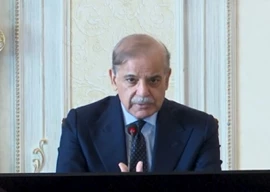
“I don’t need money, all I need is something to eat. Please uncle, do you not have at least some candies?” a five-year-old girl on the way to Diplo requested. “Whatever you have to eat, please give it to them,” pleaded her father, who was removing sand from the road with his two other children.
The father clarified that they were not beggars but were helping people by removing sand from the road. “I can’t stand to see my kids beg for food but it is the only way,” said the father. “There is no work here and I don’t have any animals that I can sell. My children haven’t eaten anything since the morning and have been working with me throughout.”
The same situation could be seen in the whole region. “Can you please ask the hotel manager to give us two cups of tea?” a man in his 40s asked shyly in Mithi, a companion alongside him.
“We are both hungry and have to spend the whole night in the city. The tea will help fight the hunger pangs,” explained one of the two men, Ibrahim, with a sad smile on his face. Ibrahim revealed why he didn’t ask for a meal. “People can afford providing us with tea as compared to a whole meal. There is no need to attack the pockets of others when we can reduce our hunger with tea.”
An aged woman, Khatoon, stood on the side of the road near Chelhar town along with two minors. “Thanks for accompanying us,” she said. “Every vehicle just crosses and no one has time for us. Can you please tell me where I could get some food for my children?”
The children she was referring to were without shoes, standing barefoot on the desert sand in the hot weather. Their twinkling eyes illustrated a strange sense of helplessness. “I am hungry,” said one of them.
In the desert, it is hunger that often speaks. Whether it is a young boy or a girl, a man or a woman or even a small child, one can easily identify the clear signs of an unfilled appetite. ‘Hunger’ is one of the most commonly used words across the Tharparkar district.
“Our children die of hunger,” said Muhammad Yousuf, an aged man of the Peeloro village. “This also kills our animals. It is not a new issue. We have been suffering from starvation for years - we are used to this and for us, this is not an issue but a disease.”
In rural Thar, there are no lavish meals, only roti and red-chili. A glass of milk or lassi is an additional supplementary in their dinners - a luxury rather than a necessity. “I know many who can’t even afford two meals a day. This compels them to ask for food when someone wants to donate money,” Yousuf clarified. The people of Thar eat economically, planning ahead. Their food is divided not in days but in months. The concept of having three meals in a day is rare.
The first meal is taken in the afternoon and the second meal is soon after sunset.
“It is an issue of affordability,” a woman of Diplo, Parri, commented. “Only people in cities can afford three meals in a day, not in rural Thar.”
A writer of Tharparkar, Khalid Kumbahr, said that except for Mithi, all those who live in the area experience starvation. “All, including birds, animals and human beings, know what hunger is in this region. It is not a new phenomenon.”
Published in The Express Tribune, March 12th, 2014.

















COMMENTS
Comments are moderated and generally will be posted if they are on-topic and not abusive.
For more information, please see our Comments FAQ